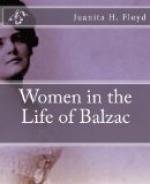“(4) My aunt Eve was neither married in 1818 nor in 1822 to Mr. Hanski, but in 1820. It was not because of revers de fortune that she was married to him, but it was the custom in Polish noble families to try to settle girls as richly as possible. Later on, my grandfather lost a great deal of money, but this circumstance, which occurred after my aunt’s marriage, had nothing to do with it. My grandfather,—this by the way,—was a very remarkable man, a personal friend of Voltaire. You will find interesting details about him in an amusing book published by Ernest Daudet, called La Correspondence du Comte Valentin Esterhazy, in the first volume, where among other things is described the birth of my aunt Helene, whose personality interests you so much, a birth which nearly killed her mother. Besides Helene, my grandparents had still another daughter who also died unmarried, at seventeen years of age, and who, judging by her picture, must have been a wonder of beauty; also a son Stanislas, who was killed accidentally by a fall from his horse in 1826.
“(5) My uncle Ernest was not the second
son of his parents, but the
youngest in the whole family.”
It is interesting to note that Balzac wished to have his works advertised in newspapers circulating in foreign countries and wrote his publisher to advertise in the Gazette and the Quotidienne, as they were the only papers admitted into Russia, Italy, etc. He repeated this request some months later, by which time he not only knew that l’Etrangere read the Quotidienne, but he had become interested in her.
As has been mentioned, it is a strange coincidence that this first letter from l’Etrangere arrived on the very day that the novelist wrote accepting the invitation of the Duchesse de Castries. Balzac doubtless little dreamed that this was the beginning of a correspondence which was destined to change the whole current of his life.
Many versions have been given as to what this letter contained, some saying that Madame Hanska had been reading the Peau de Chagrin, others, the Physiologie du Mariage, and others, the Maison du Chat-qui-pelote, but if the letter no longer exists how is one to prove what it contained? Yet it must have impressed Balzac, for he wanted to dedicate to her the fourth volume of the Scenes de la Vie privee in placing her seal and “Diis ignotis 28 fevrier 1832” at the head of l’Expiation, the last chapter of La Femme de trente Ans, which he was writing when her letter arrived, but Madame de Berny objected, so he saved the only copy of that dedication and wished Madame Hanska to keep it as a souvenir, and as an expression of his thanks.
According to Spoelberch de Lovenjoul, Balzac showed one of Madame Hanska’s letters to Madame Carraud, and she answered it for him; but with his usual skill in answering severe cross-examinations, he replies:




